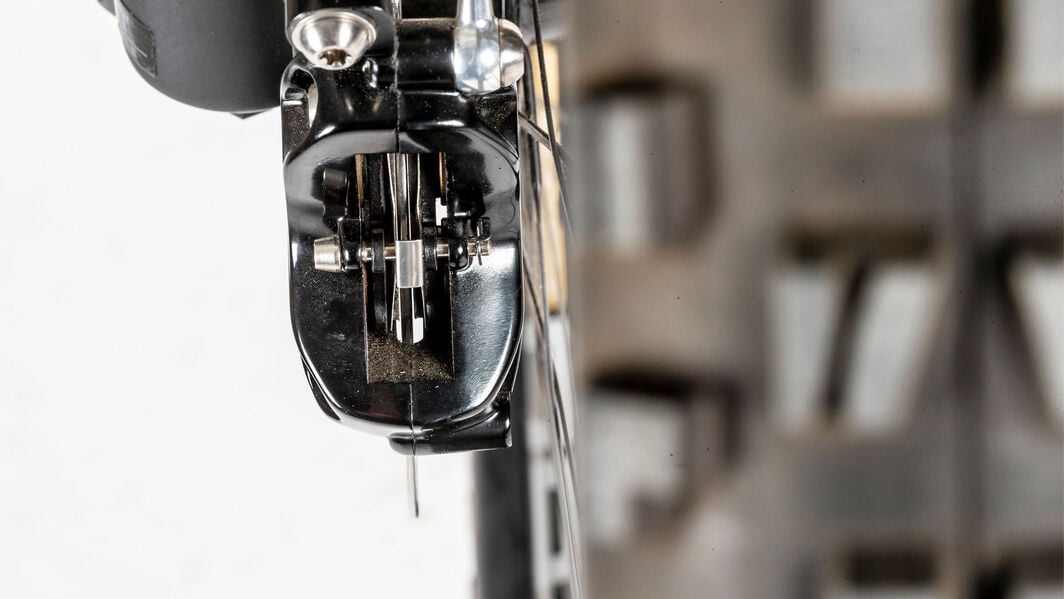The rhythmic whirring of a bike is a symphony to any avid cyclist. But when that sweet melody is overshadowed by an ear-piercing squeal, it’s time to intervene. From mild annoyances to potential safety hazards, squeaky bike brakes deserve prompt attention. In this detailed guide, we’ll delve into the depths of this common yet avoidable problem, exploring its causes, offering solutions, and delving into expert advice to help you restore the harmony of your cycling experience.

Image: www.canyon.com
Understandably, the first step towards resolving any issue is to pinpoint its root cause. Squeaky bike brakes can arise from an array of culprits, ranging from contaminated brake pads to misaligned rotors. However, some of the most frequent offenders include:
Identifying the Perpetrator
Contaminated Brake Pads
Over time, brake pads accumulate a cocktail of dirt, oil, and grime. This build-up acts as a barrier between the pads and the rotor, hindering friction and giving rise to those pesky squeals. Additionally, wet or oily conditions can exacerbate the problem.
Misaligned Rotors
When rotors are not perfectly aligned with the brake pads, they can rub against the pads unevenly. This irregular contact produces vibrations that manifest as a high-pitched squeal. Misalignments can occur due to improper installation or as a result of impacts or crashes.

Image: bikexchange.com
Worn Brake Pads
As brake pads endure countless stops, their friction material gradually wears down. When they reach their end-of-life, the backing plate of the pads starts to rub against the rotor, resulting in a distinctive screeching sound. Neglecting worn brake pads can damage your rotors and compromise braking performance.
Restoring the Silence: A Step-by-Step Guide
Equipped with an understanding of the potential causes, let’s embark on a step-by-step journey to silence those squeaky brakes:
Cleaning Contaminated Pads
Begin by removing the brake pads from the calipers. Using a rubbing alcohol-soaked cloth, gently wipe away any accumulated dirt, oil, or grease. Caution: Avoid using harsh detergents or solvents as they may damage the pads.
Aligning Misaligned Rotors
With the brake pads removed, inspect the rotors for any signs of misalignment. If necessary, use a rotor truing tool to carefully adjust the rotors until they are parallel to the brake pads. Tip: If you lack a truing tool, you can improvise by placing a piece of paper between the rotor and the brake pad. Slowly rotate the wheel while applying light pressure to the paper. The paper should drag evenly throughout the rotation, indicating proper alignment.
Replacing Worn Brake Pads
Thoroughly inspect the brake pads for signs of wear. If the friction material is less than 2mm thick or the backing plate is exposed, it’s time for new pads. Purchase replacement pads specifically designed for your bike model and follow the manufacturer’s installation instructions.
Staying Ahead of the Squeal: Preventive Measures
To avoid future squeaks and ensure optimal braking performance, embrace these proactive measures:
Regular Cleaning
Periodically clean your brake pads and rotors to prevent the accumulation of dirt and grime. A simple wipe-down with rubbing alcohol or a dedicated brake cleaner will suffice.
Proper Lubrication
Lubricating moving parts, such as brake pivots and cables, reduces friction and minimizes the likelihood of squeaks. Apply a small amount of bike-specific lubricant to these areas.
Optimal Braking Technique
Avoid sudden or forceful braking. Instead, apply the brakes gradually and modulate your pressure to reduce wear and tear on brake components. Bonus Tip: Try using two fingers to apply even pressure to both brake levers.
FAQ: Unraveling the Mystery of Squeaky Brakes
-
Q: Why do my bike brakes squeal when wet?
A: Water can act as a lubricant between the brake pads and rotors, reducing friction and causing squealing. Additionally, wet conditions may also accelerate the accumulation of dirt and debris.
-
Q: How often should I replace my brake pads?
A: The frequency of brake pad replacement depends on factors such as riding conditions, terrain, and braking habits. As a general guideline, pads should be inspected every 3-6 months and replaced when the friction material wears down to less than 2mm.
-
Q: Can I use WD-40 to lubricate my bike brakes?
A: No, WD-40 is not recommended for lubricating bike brakes. It can attract dirt and grime, potentially exacerbating the squealing problem. Use a dedicated bike-specific lubricant instead.
How To Fix Bike Brakes Squeaking
Conclusion
Remember that preventing squeaky bike brakes is not merely about silencing an annoyance but also about ensuring your safety and optimizing your cycling experience. By following the steps outlined in this comprehensive guide, you can bid farewell to ear-piercing squeals and embrace the symphony of a smoothly running bike. Remember, a well-maintained bike is a happy bike, so take pride in keeping your ride in tip-top condition.
Are you ready to silence the squeal and unlock the true potential of your bike’s braking system? Embark on this journey of maintenance and improvement, and let the smooth, quiet ride be your reward.